The problem
- Construction work performed at floor level often requires workers to stoop, squat or kneel for prolonged periods of time.
- Biomechanical research shows that high compression forces occur in the spine while stooping, and that sustained or repeated flexion of the spine may decrease the stability of the lower back and increase the risk of fatigue, leaving the back more vulnerable to injury.
- Knee osteoarthritis and discomfort are risks from the prolonged direct contact with hard surfaces while kneeling, as well as increased stress on ligaments and tendons in a squatted position.

Kneeling on floor while grouting tile
One solution
- Kneeling creepers, such as Racatac and MasterRac, can be used to eliminate squatting and stooped postures and increase comfort when kneeling.
- The padded surface on the kneeling creeper reduces the contact force on the knee compared to kneeling on hard surfaces, and improves comfort.
- Where kneeling creepers are impractical, knee pads could be used. Knee pads distribute the body weight over a larger surface area and reduce the force on the knee caps.

Performing detail work at floor level while positioned on a knee creeper
How it works
- Workers position themselves on top of the kneeling creeper and are able to sit on the seat or kneel on the knee holders while performing tasks at floor level.
- Some models of kneeling creepers are equipped with a chest support for the worker to lean on while working at low heights. The chest support reduces the loading on the spine while kneeling for prolonged periods of time.
Benefits
- The use of this product eliminates the need to squat while working at floor level, which reduces the likelihood of developing a knee or back injury.
- The low profile casters allow workers to have greater mobility while staying close to the work surface.
- The chest support on the knee creeper reduces spine loading while in the kneeling position, improving comfort and reducing muscle and joint fatigue.
- Worker productivity may improve since mobility is enhanced and discomfort is reduced.
For more information
- Products related to this solution are described at the Center for Construction Research and Training (CPWR).
- Products may also be found on the internet using the following search terms: “kneeling creeper”
- Local contractor tool and equipment suppliers or rental companies may be another source of information on products.
- For general information on this solution, call the Infrastructure Health & Safety Association at 416-674-2726 or 1-800-781-2726.
This fact sheet is adapted from Knee Creeper Tip Sheet, which we would like to give credit to the following: Albers, James T., and Estill, Cheryl F. (2007) Simple Solutions: Ergonomics for Construction Workers. DHHS, National Institute of Occupational Safety and Health (NIOSH) Publication Number 2007-122.
Construction Solutions is an online product of CPWR – The Center for Construction Research and Training. Research used to develop and maintain Construction Solutions was funded by CPWR, using grant U54 OH008307 from NIOSH. The contents are the sole responsibility of the authors and do not necessarily represent the official views of NIOSH. For more information, visit the CPWR website or CPWR's Construction Solutions website.